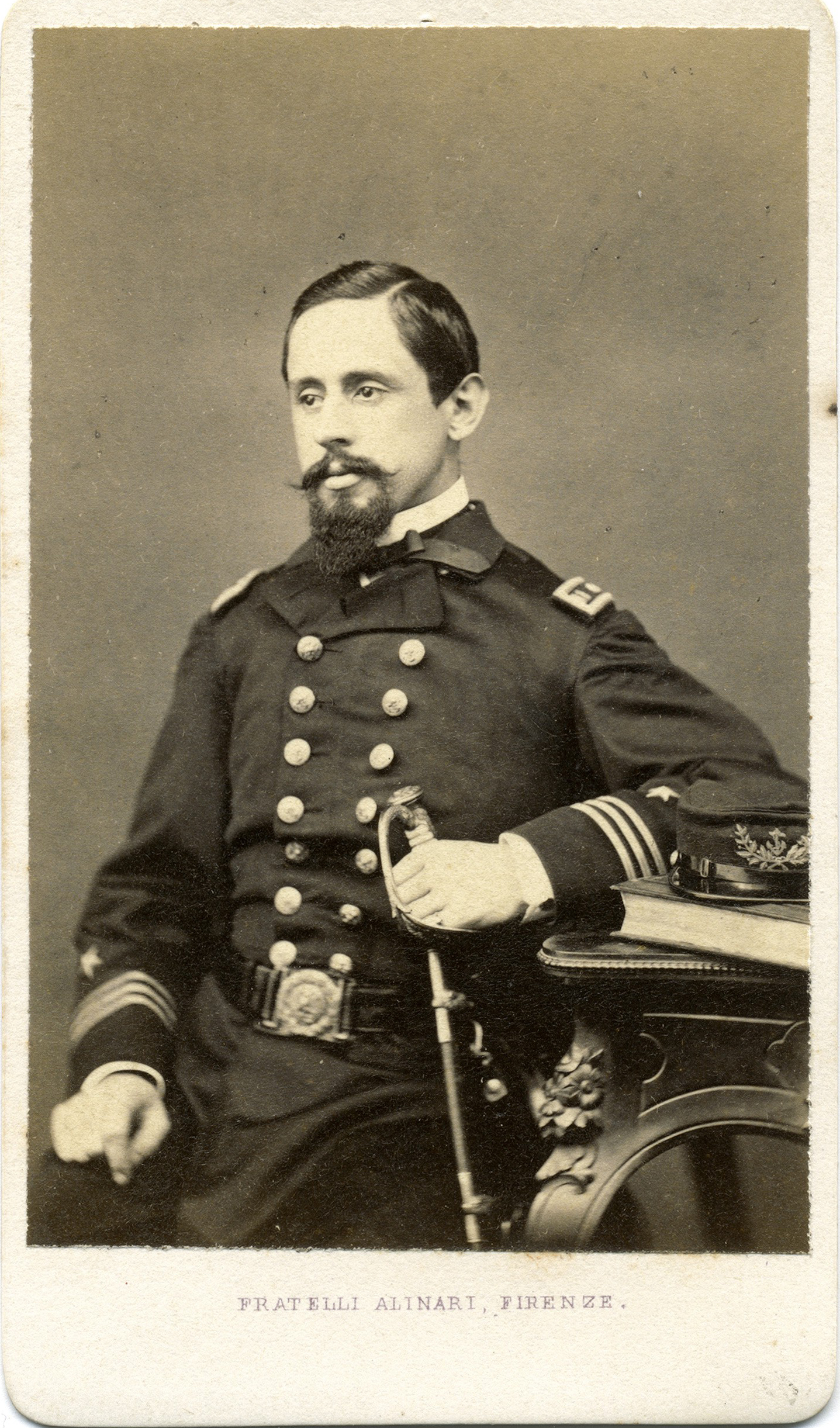Roswell Hawks Lamson came of age during a transformative period in the mid-nineteenth century. An emigrant on the Oregon Trail when he was a boy, he was the first U.S. Naval Academy cadet accepted from Oregon, a hero in the Civil War, and a U.S. District Court clerk. Because of his heroism and meritorious service in the U.S. Navy, three ships of the destroyer class were named in his honor in the early twentieth century.
Lamson was born in Burlington, Iowa, on March 29, 1838, one of four children of Jeremiah Lamson, a prosperous farmer, and Helen Hawks. Two of Lamson’s maternal great uncles had been president of the College of New Jersey (present-day Princeton University), and his mother instilled in him a lifelong passion for learning.
In 1847, nine-year-old Lamson and his family left Iowa and headed west on the Oregon Trail. They settled in the mid-Willamette Valley near the hamlet of Willamina, where the Provisional Government deeded 640 acres to Jeremiah and Helen Lamson. They eventually acquired 2,500 acres, and Jeremiah served multiple terms in the Oregon territorial legislature and four years as a Yamhill County Judge. The Lamson Homestead is on the National Register of Historic Places. The original Gothic-style house and large barn are one of the few surviving examples in the Willamette Valley from the time period.
Roswell and his siblings attended the Oregon Institute in Salem (present-day Willamette University). Within a year of his graduation in 1854, he joined the Second Washington Volunteers and fought in the Indian Wars. He served primarily in northeastern Oregon under the command of Captain James Williams of Company N Mounted Volunteers. In 1858, Roswell was accepted to the U.S. Naval Academy in Annapolis.
Lamson graduated second in his class from the Naval Academy in 1862 and took his final exams at sea, as he had already begun his military service in the American Civil War. As commander of a Union gunboat, the USS Mount Washington, he was on the James River in Virginia in June 1863 when the boat was heavily damaged by Confederate artillery. He and the crew repelled the Confederates and retained control of the ship. As a reward for his efforts, he gained the captaincy of the 221-foot, 950-ton USS Gettysburg, which at a top speed of 17.75 knots was the fastest ship in the navy. At one point, Lamson commanded more ships and men than any other officer in the navy for his rank and age. Under his command, the ship’s crew captured several Confederate blockade-runners and, toward the end of the war, sailed to North Carolina to help defeat Fort Fisher, the last Confederate stronghold on the Atlantic Coast.
In a daring attempt to destroy the fort’s walls and gun ports, Lamson volunteered to guide a hollowed-out ship packed with several thousand tons of powder within reach of the fort and explode it; but the walls of Fort Fisher held. In a final attempt, he and seventy men from the Gettysburg were part of a 2,000-man assault force that stormed the fort from the beach, while another force attacked from the sea. The Union suffered more than 1,800 casualties. Although Lamson was shot several times, he led the remaining 200 soldiers in the attack. Fort Fisher eventually fell, and several men, including future Oregon resident Alaric Chapin, received the Medal of Honor. Lamson was cited for bravery and valor and years later was awarded a naval pension in recognition of his gallant service.
Lamson resigned from the navy in July 1866 and toured Europe. He married his cousin Kate Buckingham in 1867 and worked for the Windsor Manufacturing Company before returning to Oregon in 1870 as a celebrated hero. He farmed a portion of his father’s property near Willamina for several years and in 1873 served as county clerk for Multnomah County. By 1876, he was teaching mathematics at Pacific University in Forest Grove.
In 1877, Lamson secured an appointment as clerk of the U.S. District Court in Portland, where he worked for seventeen years. The Lamsons had seven children, but only two lived to adulthood. When Kate died in 1892, his health deteriorated, and he eventually was diagnosed with locomotor ataxia (a spinal disease that caused paralysis in his legs and feet).
Roswell Lamson died in Portland on August 14, 1903. His obituary appeared on the front page of the Morning Oregonian, and at his funeral the flag from the USS Mount Washington was draped over his coffin. He is buried in River View Cemetery in Portland.
-
![]()
Roswell Hawks Lamson, carte de visite.
Courtesy U.S. National Archives (?)
-
![]()
USS Gettysburg and its officers, including Roswell Lamson.
Courtesy U.S. Navy, Naval History, 0501807
-
![]()
USS Lamson (DD-367), one of three destroyers named for Roswell Lamson, at Mare Island Navy Yard, California, 1944.
Courtesy U.S. National Archives
Related Entries
-
![Civil War, Newspaper Suppression]()
Civil War, Newspaper Suppression
Oregon's pioneer newspapers were also political organs, advancing their…
-
![Edward Baker (1811-1861)]()
Edward Baker (1811-1861)
Edward "Ned" D. Baker, who was born in London, England, on February 24,…
-
![Fort Stevens]()
Fort Stevens
One of the three major forts designed to protect the mouth of the Colum…
-
![Philip Henry Sheridan (1831-1888)]()
Philip Henry Sheridan (1831-1888)
Before he gained fame as commander of the cavalry forces of the Army of…
-
![Willamina (city)]()
Willamina (city)
Willamina, located in the northwestern Willamette Valley, is in both Ya…
Map This on the Oregon History WayFinder
The Oregon History Wayfinder is an interactive map that identifies significant places, people, and events in Oregon history.
Further Reading
Fletcher, Randol B. A Hidden History of Civil War Oregon. Charleston: The History Press, 2011.
McPherson, James and Patricia. Lamson of the Gettysburg: The Civil War Letters of Lieutenant Roswell H. Lamson U.S. Navy. New York: Oxford University Press, 1997.








